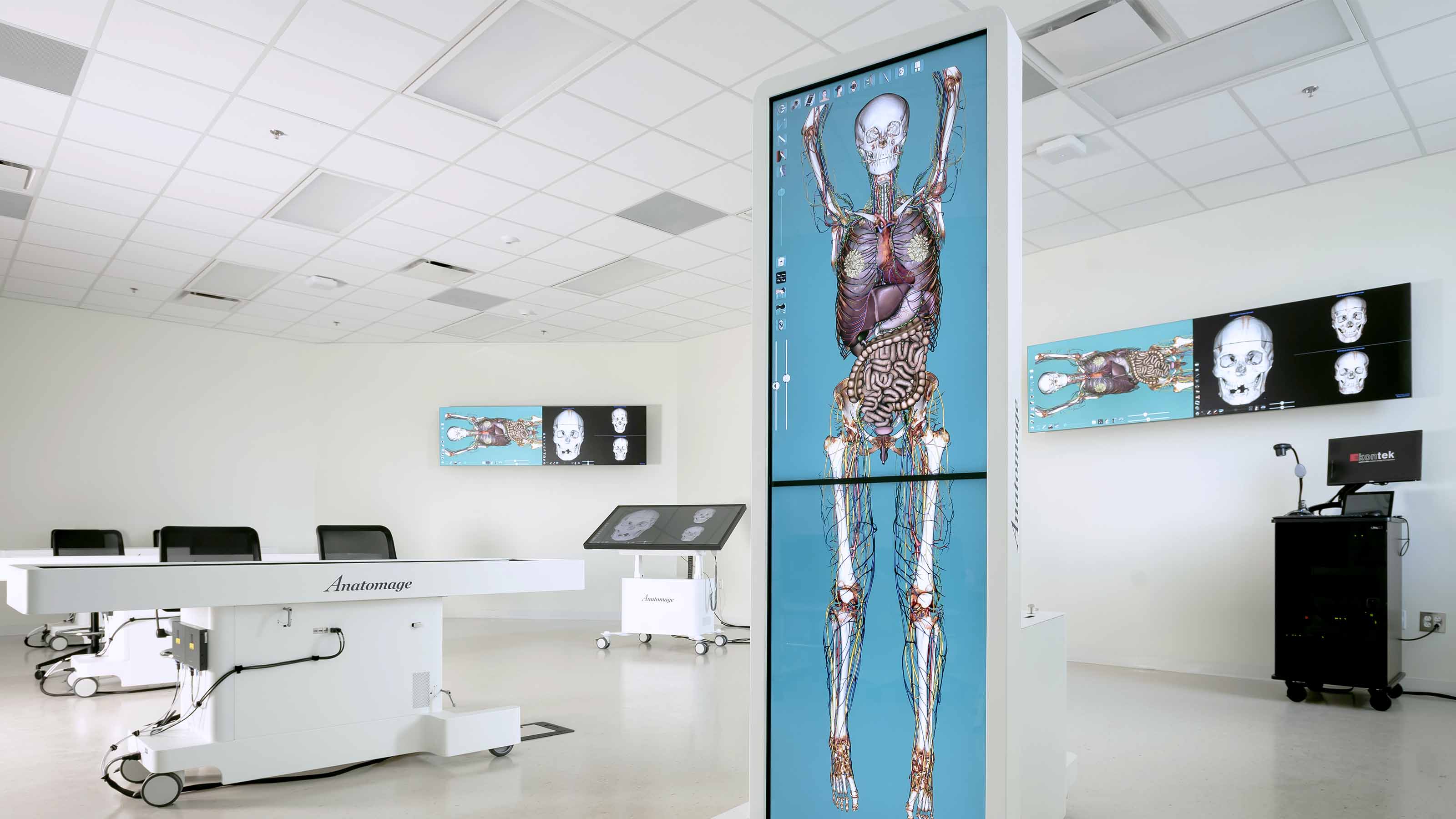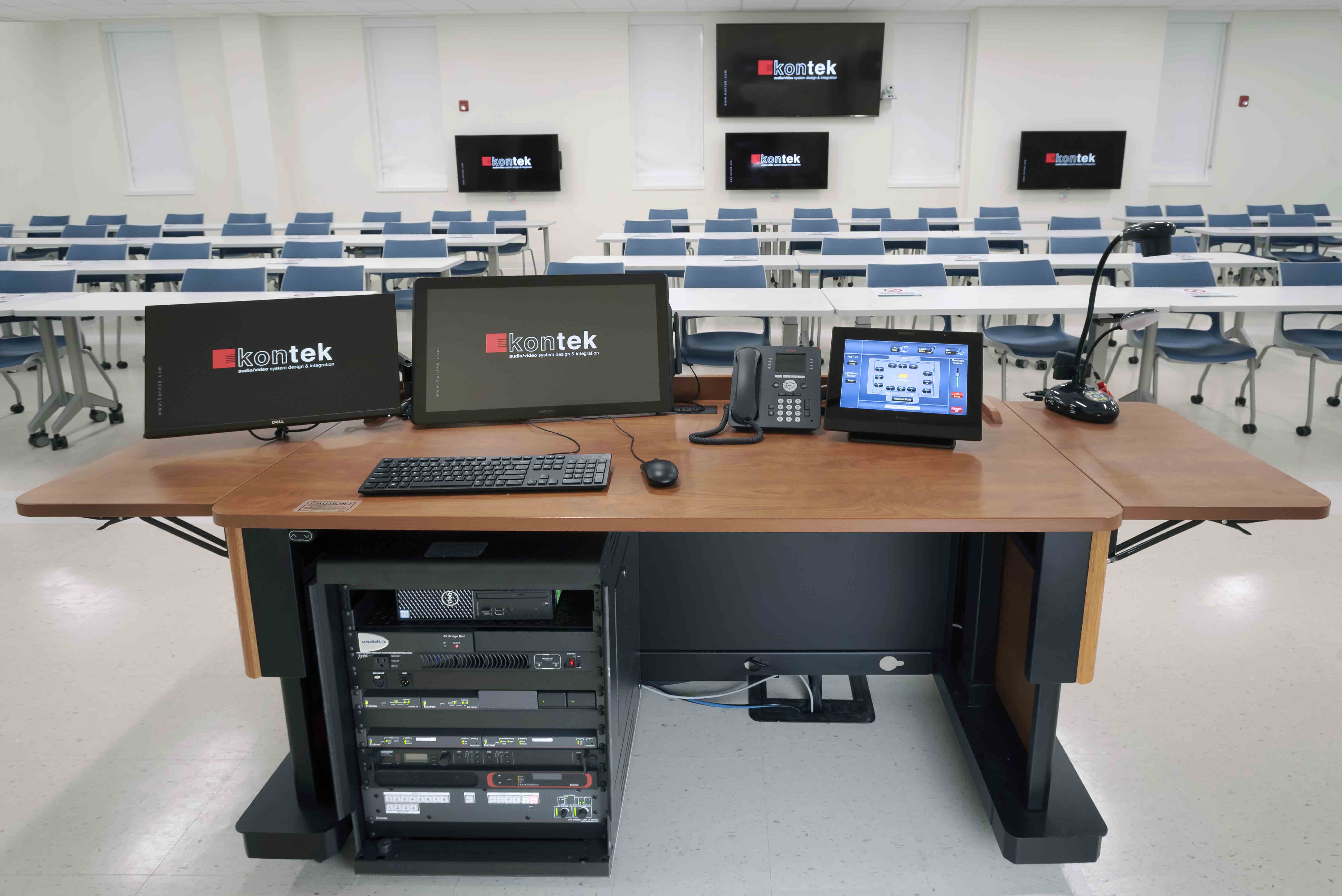Full-Scale Flexibility
The University of North Carolina at Wilmington leverages AVoIP technology for its active learning spaces.

The University of North Carolina at Wilmington (UNCW) is an R2 doctoral university known for its focus on research. In 2018, UNCW began construction on Veterans Hall, a new 145,000-square-foot facility that houses the College of Health and Human Services, as well as the Department of Chemistry and Biochemistry and the Office of Military Affairs. The building opened in August 2020.
This building is the first on UNCW’s campus to feature classrooms designed specifically for active learning. According to Robb Mann, CTS-I, manager of integrated educational technologies, the institution’s foray into active learning began before the pandemic hit. “[The university] saw this as a coming trend, and in talking to students, discerned that there was an interest in it,” he noted.
[New Extron ShareLink Pro Upgrade Adds Active Learning Support]
In addition to nine active learning classrooms ranging from 35-48 seats, Veterans Hall houses four labs (including one for anatomy and another for the movement sciences), two large 96-seat lecture halls, as well as conference rooms and huddle spaces. The active learning classrooms and labs are integrated with a distance learning control room for centralized monitoring, management, and lecture capture. UNCW worked with AEI (Affiliated Engineers Inc.), headquartered in Madison, WI, on AV system design, and KONTEK Systems, based in Durham, NC, on integration.
Adapting To Faculty
At the heart of the AV system is the Extron NAV Pro AV over IP distribution and switching platform. Each classroom, lab, or lecture hall is equipped with an Extron NAV E 101 1G encoder and NAV SD 101 1G scaling decoder, with 10G uplinks to Cisco Catalyst 9300 Series switches. Via PIM (Protocol Independent Multicast), control room operators may provide overflow between these spaces.
UNCW opted for an AVoIP system for its flexibility. “What it allows us to do is get that bespoke experience for people,” Mann explained, referring to the technology’s ability to adapt to individual faculty members’ needs. For example, because control room operators can man the cameras remotely, they can accommodate instructors who move around a lot and want the camera to follow them.

The technology’s remote monitoring capabilities also facilitate training and troubleshooting. “This was a fairly new concept [for UNCW] and we knew there was going to be a learning curve,” he said. “We can help the faculty remotely––I can monitor their experience. [We believed] that would make this adoption easier.”
A daily selection of the top stories for AV integrators, resellers and consultants. Sign up below.
Mike Werner, director of UX design and technology at KONTEK Systems, has seen an increasing number of higher education institutions inquiring about or adopting AVoIP technology. “With your standard point-to-point cabling and a switcher chassis, you’re limited on what you can do,” he said. “For flexibility, we’re seeing the shift to AVoIP a lot more.”
Programming Control
In the Veterans Hall control room, two Extron NAVigator Pro AV over IP System Manager devices provide control over the entire NAV system. The devices are on a separate network with IPv4 routing to NAV.
UNCW’s Richard Blaycock, CTS-I, systems engineer for integrated technologies, programmed the Extron system via the Extron ControlScript platform. With ControlScript, Blaycock established network communication between the control processors to create a client-server relationship between classrooms, labs, lecture halls, and the control room. Each room’s mode and current active input are regularly sent back to the control room for monitoring, and operators can send commands back to the teaching spaces when required.

The classrooms, labs, and lecture halls are outfitted with Vaddio RoboSHOT PTZ cameras, Shure MXA910 ceiling microphone arrays, and Biamp Tesira Forte DSP processors (programmed by KONTEK), which can be controlled from the control room. Operators can also monitor all ongoing classes and labs, as well as troubleshoot in real time.
In class, instructors launch a Zoom session, and control room operators capture content for streaming and archiving. Onsite students can connect to the system wirelessly via the Mersive Solstice collaboration platform that is integrated into each space.
Proof of Concept
The system was deployed in 2020––good timing, Mann acknowledged, considering it was during the height of the pandemic. Prior to rollout, UNCW tested the systems in a pilot AVoIP active learning classroom. The proof of concept enabled Mann and his team to address issues before deploying at full scale.
While the pilot classroom included eight network endpoints linking back to the control room, there are now 250 endpoints throughout Veterans Hall. The pilot also allowed UNCW to develop its gold configuration for its network servers, and was used to train faculty on instruction in an active learning space.

After two years at full scale, Mann said Veterans Hall serves as a model for the entire campus; UNCW is currently working on a similar project for its School of Nursing. “We’re able to take the design concept from Veterans Hall and replicate it in other classrooms,” he added.
Thom Mullins, CTS, CTS-D, senior consultant at AEI, noted that UNCW’s AV team’s close ties with the university’s IT department (of which AV is a subgroup) helped to streamline the project. “It was a really good group of people to work with, and I was very grateful that they had a very tight alliance with networking,” he said. “As a result, a lot of the things that we ran into from a network standpoint that tend to be hiccups with other installations were not a hiccup with them at all.”
[AVoIP Standards: The Fight to Get It Right]
Mullins acknowledged that this isn’t always the case; in facilities where AV and networking are less aligned, the discovery process may take longer. “We try to understand what the client’s standards are as much as possible if they have those––not just industry standards such as those authored by AVIXA, but it may be their own internal standards,” he explained. Those standards can include manufacturer preferences, network segregation issues, or security requirements. “It just takes a little more time and care, particularly when the two groups don’t really understand what [each other’s] requirements are. We have to stand in the middle to help both groups communicate.”
It’s All About Relationships
Robb Mann, CTS-I, manager of integrated education technologies at UNCW, attributes the success of this project to the strong collaboration between the university’s AV team and its networking group. “We’re both in IT here––which made the collaboration easier––but we have an especially close working relationship with our network folks here, which made things go very smoothly,” he said.
Early in the project, each team would meet to iron out the details related to network architecture, budgeting, and where network switches would be housed. “It made things easy in getting that side of the system up and running," Mann added. "If you’re going to do AVoIP, it is critical to get the network team on board early, and to have a strong working relationship with them throughout the process.”
Carolyn Heinze has covered everything from AV/IT and business to cowboys and cowgirls ... and the horses they love. She was the Paris contributing editor for the pan-European site Running in Heels, providing news and views on fashion, culture, and the arts for her column, “France in Your Pants.” She has also contributed critiques of foreign cinema and French politics for the politico-literary site, The New Vulgate.
